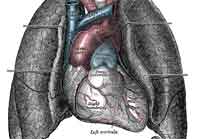Difference Between Atria and Ventricles

Atria (pl. atrium) refer to the upper chambers of the heart (2 in number) that receive the impure blood from the veins to send it to the ventricles. On the other hand, ventricles are small cavities or chambers that are present within an organ, usually the left chamber of the heart that accepts blood from the arteries (left atrium) and then contracts to force into the aorta. The right chamber of the heart accepts deoxygenated blood that is carried by the right aorta. There are 4 chambers in the heart and the atria refer to the upper chambers, whereas the ventricles refer to the lower chambers. The right part of our heart has an atrium and one ventricle, while the case is the same for the left side too.
The walls of the ventricles are thicker, while that of the atria are thinner. They however contain valves to pump the blood in and out of the heart. The walls of the heart, including the atria and the ventricles are functional in ensuring effective working of the circulatory system. The walls of the heart are made of 3 layers of tissues ‘“ myocardium, endocardium and epicardium. The function of the right atrium is to receive deoxygenated blood from the veins. Its oxygen has been given to the tissues in return collecting CO2 and tissue waste materials. Deoxygenated blood is transferred from the upper part of the body to the atrium by the SVC or superior vena cava. The IVC or inferior vena cava brings deoxygenated blood from the lower part of the body into the atrium.
The tricuspid valve of the right atrium helps in the storage of blood, for the heart to pump it within the right side of the ventricle for preventing the blood from flowing back, as well as ensure effective cardiac functionality. The function of the left atria is to accept the purified blood from lungs from the pulmonary veins. The mitral or bicuspid valve helps prevent the blood from flowing backwards to the left part of heart until the left side of the atrium pushes blood to the left of the ventricle.
The right ventricle functions by depositing deoxygenated blood that is contained in the right atria. The right ventricle pumps blood into the lungs for purifying it. Of course the purification process is forwarded by the pulmonary valve. Pulmonary arteries transport blood into the lungs. The function of the muscled left ventricles is to receive oxygenated blood that has been pumped within left atria in the body.
Summary:
1. The atria stand for the upper chambers of the heart, while the ventricles are the lower chambers.
2. Atria act as receptors of deoxygenated blood, while ventricles receive blood from the left atria and force it into the aorta.
3. Atria have strictly to do with the inner chambers of the heart, while ventricles may even refer to the interconnected brain cavities.
4. The walls of the atria are thinner with low blood pressure, while those of the ventricles are thicker with high blood pressure.
- Difference Between Fish and Reptiles - August 10, 2011
- Difference Between Xeon and i7 - January 7, 2010
- Difference Between GPS and AGPS - December 20, 2009
Search DifferenceBetween.net :
7 Comments
Trackbacks
- Difference Between Aortic Valve and Mitral Valve | Difference Between | Aortic Valve vs Mitral Valve

Thank you
Has so bad information is caca
Very helpful content s
Thanks
Very helpful. Thank you Very much. Perhaps the peson who found this “caca” didn’t read the whole article.
Hi